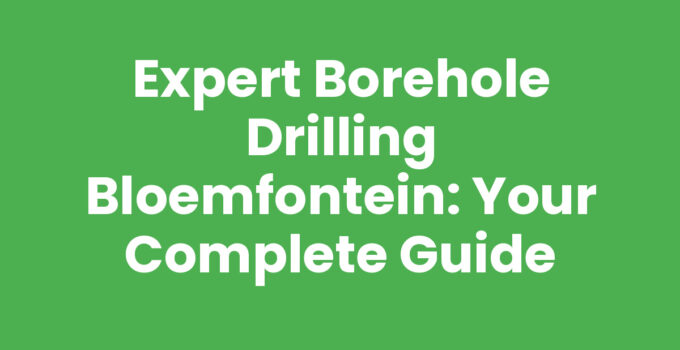Welcome to our comprehensive guide on borehole drilling in Bloemfontein! As water scarcity becomes a pressing issue worldwide, many residents and businesses in Bloemfontein are turning to borehole drilling as a sustainable and efficient solution. In this article, we will discuss what borehole drilling entails, the benefits it offers, and a step-by-step guide on how to go about it.
Borehole Drilling Bloemfontein: A Step-by-Step Guide
Borehole drilling is the process of creating deep, vertical holes in the ground to access groundwater. This method is increasingly popular for both agricultural and residential purposes in Bloemfontein, where reliable water supply is crucial. Here’s a detailed guide to understanding the borehole drilling process.
Step 1: Assess Your Water Needs
Before starting the borehole drilling process, it’s essential to assess your water needs. Determine the purpose of the borehole – is it for irrigation, household use, or industrial purposes? Understanding your water consumption requirements will guide the size and depth of the borehole.
Step 2: Research Local Regulations
In Bloemfontein, borehole drilling is subject to specific regulations. It’s vital to check with local authorities regarding permits and regulations to ensure compliance. This research will also help avoid potential legal issues down the line.
Step 3: Hire a Reputable Drilling Company
Finding an experienced and reputable drilling company is crucial. Look for testimonials and reviews from previous clients. Ensure they have the necessary equipment and expertise to handle different soil types in Bloemfontein.
Step 4: Conduct a Site Assessment
The drilling company will conduct a site assessment to identify the best location for the borehole. This includes evaluating the geology, soil type, and proximity to other water sources. Proper positioning enhances the likelihood of accessing quality groundwater.
Step 5: Begin the Drilling Process
Once site assessment is complete, drilling can commence. The process often begins with the drilling of a pilot hole which will be expanded to the desired diameter and depth. The use of specialized drilling rigs makes the process efficient and capable of reaching depths where groundwater is abundant.
Step 6: Installing the Borehole Casing
After reaching the required depth, a borehole casing is installed to prevent the walls from collapsing. This casing also helps filter out sediments, ensuring that the water remains clean and suitable for use.
Step 7: Water Quality Testing
Post-drilling, it’s critical to test the water quality. This includes checks for contaminants and minerals that could affect usability. Testing should be done by accredited laboratories to ensure accurate results.
Step 8: Assemble the Pumping System
Once the water quality is verified, the next step is to install a pumping system to extract water from the borehole. There are various pumping systems available, depending on your water needs and usage levels.
Step 9: Regular Maintenance and Monitoring
After installation, maintaining your borehole is key. Regular checks will ensure the pump is functioning efficiently and that the water quality remains safe for consumption. Schedule annual inspections and perform necessary repairs promptly.
Further Reading: Top Gyms in Bloemfontein: Find Your Perfect Fitness Place
Benefits of Borehole Drilling in Bloemfontein
Beyond simply providing access to water, borehole drilling offers several benefits that make it a favorable option for residents and businesses:
- Cost-Effective: While the initial investment may be high, boreholes significantly reduce long-term water costs, especially for agricultural users.
- Self-Sufficiency: A borehole provides an independent water source, reducing reliance on municipal water supply systems.
- Increased Property Value: Properties equipped with a borehole can see an increase in value and appeal due to the added resource.
Further Reading: University Term Dates CUT, Bloemfontein: Key Academic Dates
Important Considerations Before Drilling
While borehole drilling offers many advantages, there are important considerations to keep in mind:
- Environmental Impact: Over-extraction can lead to depletion of underground aquifers, so it’s important to manage usage sustainably.
- Initial Costs: Consider the upfront costs of drilling, equipment, and installation. Always ask for quotes and compare services.
- Regulations: Ensure to comply with local regulations and obtain necessary permits before beginning the drilling process.
In conclusion, borehole drilling in Bloemfontein can be an excellent solution for sustainable water access. By following the steps outlined in this guide and considering both the benefits and challenges, you’ll be well-equipped to make informed decisions regarding your borehole project.
You Might Also Like: Discovering Taylor Street, Bloemfontein: A Local’s Guide
Frequently Asked Questions
What is borehole drilling?
Borehole drilling is the process of creating deep, vertical holes to access groundwater.
How deep should a borehole be?
The depth of a borehole depends on local geology and water needs, typically ranging from 30 to over 100 meters.
Is borehole water safe to drink?
Yes, borehole water can be safe to drink if tested and treated for contaminants.



